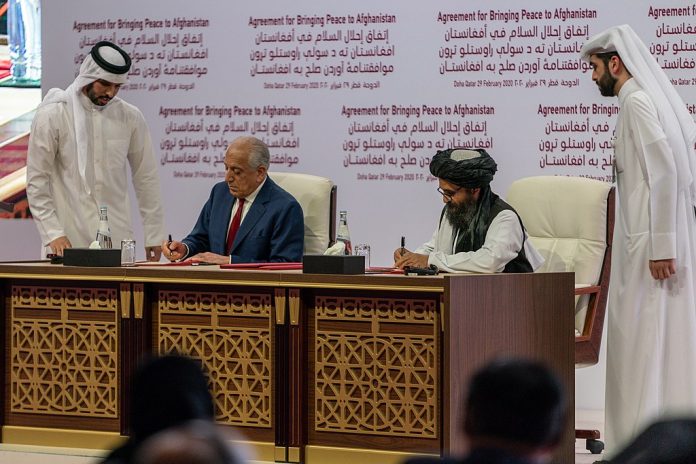The pandemic caused by the new coronavirus has overshadowed the historical accord signed on February 29 between the Afghan Taliban and the United States. Overshadowing the agreement and its subsequent international endorsement is understandable in view of the incidence and impact of COVID-19.
Welcoming the US-Taliban accord, the UN Security Council on March 10 adopted a resolution calling the accord a significant step ‘towards ending the war and opening the door to intra-Afghan negotiations’. This step by the UN was an important development because it marked an international endorsement of the agreement signed in Doha, Qatar between the Taliban and the US.
The intra-Afghan talks, scheduled from March 10, have not gone underway and have been pushed to background due to the ongoing deadlock over the prisoners’ release and the parallel inauguration ceremonies of the Afghan president on March 9. All these developments have stalled the peace process, creating a volatile political situation after the Doha accord in the war-ravaged country. The accord envisioned a peace process to begin with all Afghan parties on board. However, the road to peace has seen another obstacle: the Taliban have intensified attacks on the Afghan forces while the latter has vowed to retaliate strongly.
The noteworthy part of the Doha agreement is its thrust on Washington’s commitment to a total but phase-wise withdrawal of its troops in return for the Taliban’s commitment to strictly follow the agreed roadmap. In accordance with the agreement, the Taliban are required to prevent Afghan soil from being used against the US and to engage in intra-Afghan talks involving the Afghan government. Apart from this, enshrined in the deal are certain aspirational goals and the responsibility of the Afghan factions to negotiate a ceasefire and a political settlement to end the conflict.
Interestingly, the Doha deal provides for the intra-Afghan talks to begin on March 10 but it does not specify the time to conclude them. It also does not specifically say anything about the timeframe of the formation of government – to be framed within the 14-month period of the US exit or after it. This raises serious questions about the future government in Afghanistan and about the commitment behind signing of the February 29 agreement.
It appears that the agreement was signed in haste and lacked in strategic thinking. Perhaps it was signed to allow US president Donald Trump to bring his troops home ahead of his re-election this November. Thus the accord implies, behind its framing, the domestic political scenario of America apart from enabling Trump to deliver on his election promise of pulling his troops out of Afghanistan. His intent to withdraw the troops, whether peace comes to Afghanistan or not , got the top priority. In fact, post Doha deal, Trump said, “Countries have to take care of themselves. You can only hold someone’s hand for so long.”
Meanwhile, the disagreement over the release of prisoners has turned out to be a key hinderence in the negotiation process to commence. The Taliban maintain that the prisoner release is a key condition for beginning the intra-Afghan negotiations. But Ashraf Ghani seems determined not to go for the prisoners’ release, possibly seeking to strengthen his position and to delay the peace process with the hope of earning some leverage.
The brinkmanship, highlighted by the political crisis involving Ghani and his rival Abdullah Abdullah over the disputed presidential elections, can push the country back into political chaos if their tussel is not immediately resolved. The unabated crisis would delay the intra-Afghan dialogue, pushing the Taliban to the periphery. Not in the central stage , the insurgents are likely to operate with renewed determination to gain an upper hand in the Afghan political set-up. The Taliban would look for mounting pressure on Ghani and Abdullah.
Although the US special envoy to Afghan peace process Zalmay Khalilzad prolonged his stay in Kabul, he has not been able to resolve the issue of parallel governments and to break the deadlock over the prisoners’ release. This leaves an uncertain future for the intra-Afghan negotiations promised in the Doha roadmap.
For the Doha-agreement to get going and conclude successfully, the best course of action is that the main parties abide by the agreement, ensure low or no violence and stop the spoilers of the peace process. Meanwhile, the principal parties need to ensure the intra-Afghan dialogue does not fail to resolve the core issues if and when it gets underway. The failure of the negotiations can lead to renewed violence, forcing America to slow down its troop withdrawal and pushing Afghanistan into a situation of political turmoil and chaos.
The views and opinions expressed in this article are those of the author.

Sheikh Shabir Kulgami is a Kashmiri (Indian) political commentator, analyst and columnist. He writes extensively on South Asia.


